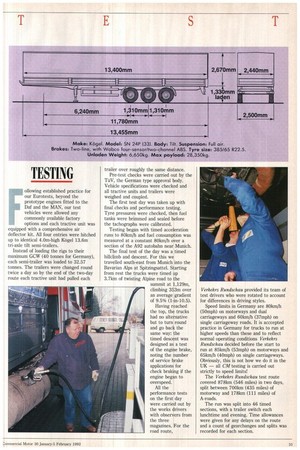TESTING
Page 33

If you've noticed an error in this article please click here to report it so we can fix it.
Following established practice for our Eurotests, beyond the prototype engines fitted to the Daf and the MAN, our test vehicles were allowed any commonly available factory options and each tractive unit was equipped with a comprehensive air deflector kit. All four entries were hitched up to identical 4.0m-high Kogel 13.6m tri-axle tilt semi-trailers.
Instead of loading the rigs to their maximum GCW (40 tonnes for Germany), each semi-trailer was loaded to 32.57 tonnes. The trailers were changed round twice a day so by the end of the two-day route each tractive unit had pulled each trailer over roughly the same distance.
Pre-test checks were carried out by the TiiV, the German type approval body. Vehicle specifications were checked and all tractive units and trailers were weighed and coupled.
The first test day was taken up with final checks and performance testing. Tyre pressures were checked, then fuel tanks were brimmed and sealed before the tachographs were calibrated.
Testing began with timed acceleration runs to 80km/h and fuel consumption was measured at a constant 80Iun/h over a section of the A92 autobahn near Munich.
The final test of the day was a timed hiticlimb and descent. For this we travelled south-east from Munich into the Bavarian Alps at Spitzingsattel. Starting from rest the trucks were timed up 3.7km of twisting Alpine road to the summit at 1,129m, climbing 353m over an average gradient of 9,5% (1-in-10.5).
Having reached the top, the trucks had no alternative but to turn round and go back the same way: the timed descent was designed as a test of the engine brake, noting the number of service brake applications for check braking if the engine began to overspeed.
All the performance tests on the first day were carried out by the works drivers with observers from the three magazines. For the road route,
Verkehrs Rundschau provided its team of test drivers who were rotated to account for differences in driving styles.
Speed limits in Germany are 801cm/h (50mph) on motorways and dual carriageways and 60km/h (37mph) on single carriageway roads. It is acccepted practice in Germany for trucks to run at higher speeds than these and to reflect normal operating conditions Verkehrs Rundschau decided before the start to run at 85km/h (53mph) on motorways and 65km/h (40mph) on single carriageways. Obviously, this is not how we do it in the UK — all CM testing is carried out strictly to speed limits!
The Verkehrs .Rundschau test route covered 878km (546 miles) in two days, split between 700km (435 miles) of motorway and 178km (111 miles) of A-roads.
The run was split into 46 timed sections, with a trailer switch each lunchtime and evening. Time allowances were given for any delays on the route and a count of gearchanges and splits was recorded for each section.
















































































